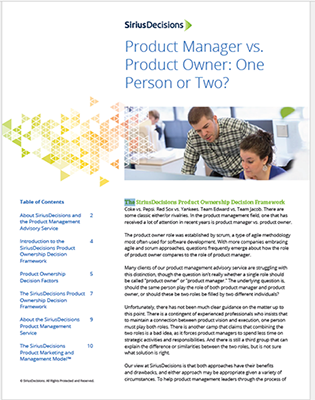Product Manager vs. Product Owner in Agile: One Person or Two?
- The product owner role was established by scrum, a type of agile methodology most often used for software development
- Should the same person be both product manager and product owner, or should these be roles filled by two different individuals?
- Our view is that both approaches have benefits and drawbacks, and either approach may be appropriate in a variety of circumstances
Coke vs. Pepsi. Red Sox vs. Yankees. Team Edward vs. Team Jacob. There are some classic either/or rivalries. In the product management field, one that has received a lot of attention in recent years is product manager vs. product owner.
 The product owner role was established by scrum, a type of agile methodology most often used for software development. With more companies embracing agile and scrum approaches, questions frequently emerge about how the role of product owner compares to the role of product manager.
The product owner role was established by scrum, a type of agile methodology most often used for software development. With more companies embracing agile and scrum approaches, questions frequently emerge about how the role of product owner compares to the role of product manager.
Many clients of our product management advisory service are struggling with this distinction, though the question isn’t really whether a single role should be called “product owner” or “product manager.” The underlying question is, should the same person play the role of both product manager and product owner, or should these be two roles be filled by two different individuals?
Unfortunately, there has not been much clear guidance on the matter up to this point. There is a contingent of experienced professionals who insists that to maintain a connection between product vision and execution, one person must play both roles. There is another camp that claims that combining the two roles is a bad idea, as it forces product managers to spend less time on strategic activities an responsibilities. And there is still a third group that can explain the difference or similarities between the two roles, but is not sure what solution is right.
Our view at SiriusDecisions is that both approaches have their benefits and drawbacks, and either approach may be appropriate given a variety of circumstances. To help our clients through the process of deciding which approach is right for them, we have created the SiriusDecisions Product Ownership Decision Framework.
Clients of our product management advisory service can access the accompanying research brief Product Manager vs. Product Owner: One Person or Two?. We have also made a version of this research brief available to non-clients.
The reason that there isn’t a one-size-fits-all answer is that there are different situations that require different factors to be considered. For example, take the case of a small team developing a new UI-heavy product. Responsibilities like market sizing, segmentation and pricing may sit with a capable and well-staffed product marketing team, and given that the product isn’t yet in the market, the product manager does not have significant sales support responsibilities. So, the product manager currently is focused primarily on the product development effort. Given the nature of the product, there needs to be tight collaboration with a dedicated user experience designer. If the product manager is skilled enough and has the bandwidth to take on both the product manager and product owner roles, this would likely be ideal; in fact, splitting those roles among two people in this situation may be not just unnecessary but also counterproductive.
On the other hand, take the case of a very technical product that is well established in a market. The team is new to scrum, and the developers have a lot of detailed questions that need discussion and support on a daily basis, because the stories relate to aspects buried deep inside the system. Additionally, functions like product marketing and sales engineering are understaffed, and product management is taking on some of those functions’ responsibilities alongside “traditional” product management activities like pricing, competitive analysis and lifecycle management. In this case, it may be preferred to have one person act as product manager and a separate person act as product owner. This will ensure the product owner can provide support needed for the scrum team and that the product manager can cover the other key responsibilities. Among other things, coordination between the two individuals will be key to success here.
Clients of the SiriusDecisions Product Management advisory service also have access to a related research brief: Product Manager and Product Owner: Maximizing the Effectiveness of Both Roles. In this brief, we highlight the aspects to consider to maximize the effectiveness of both roles and the agile team – no matter which approach is chosen.
There is no one “right” approach to determine the staffing of the product manager and product owner roles. Regardless of setup, there are risks, benefits and unique considerations, and what works well for one organization may be inappropriate for another. The needs and considerations will likely change over time as well. We hope that the SiriusDecisions Product Ownership Decision Framework can be a helpful guide to making the best decision for your organization now and in the future.
